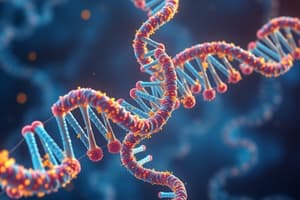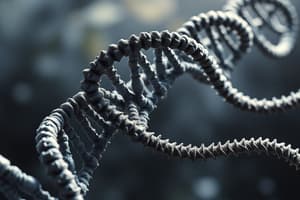Podcast
Questions and Answers
What is the primary enzyme responsible for joining Okazaki fragments on the lagging strand during DNA replication?
What is the primary enzyme responsible for joining Okazaki fragments on the lagging strand during DNA replication?
- DNA polymerase
- DNA helicase
- RNA polymerase
- DNA ligase (correct)
During DNA synthesis, in which direction are new nucleotides added to the growing strand?
During DNA synthesis, in which direction are new nucleotides added to the growing strand?
- 5' to 5'
- 3' to 5'
- 3' to 3'
- 5' to 3' (correct)
Which of the following statements best describes the difference between the leading and lagging strands during DNA replication?
Which of the following statements best describes the difference between the leading and lagging strands during DNA replication?
- Both strands are synthesized in Okazaki fragments.
- The leading strand is synthesized continuously, while the lagging strand is synthesized in Okazaki fragments. (correct)
- Both strands are synthesized continuously.
- The leading strand is synthesized in Okazaki fragments, while the lagging strand is synthesized continuously.
What is the structure formed during DNA replication that includes the Y-shaped region where DNA is unwound?
What is the structure formed during DNA replication that includes the Y-shaped region where DNA is unwound?
What type of RNA is responsible for bringing amino acids to the ribosome during protein synthesis?
What type of RNA is responsible for bringing amino acids to the ribosome during protein synthesis?
What describes a heterozygous trait?
What describes a heterozygous trait?
Which statement best illustrates Mendel’s Law of Independent Assortment?
Which statement best illustrates Mendel’s Law of Independent Assortment?
Which type of inheritance occurs when both alleles contribute equally to the phenotype?
Which type of inheritance occurs when both alleles contribute equally to the phenotype?
What happens during nondisjunction?
What happens during nondisjunction?
Which enzyme is responsible for unzipping the DNA double helix during replication?
Which enzyme is responsible for unzipping the DNA double helix during replication?
What does the SRY gene determine?
What does the SRY gene determine?
Which of the following best explains epistasis?
Which of the following best explains epistasis?
Which base pairs with adenine in DNA?
Which base pairs with adenine in DNA?
Flashcards
Homozygous Trait
Homozygous Trait
A trait where both alleles are the same (e.g., AA or aa).
Heterozygous Trait
Heterozygous Trait
A trait with two different alleles (e.g., Aa).
Mendel's Law of Segregation
Mendel's Law of Segregation
Each individual has two alleles for a gene, which separate during gamete formation, with each gamete receiving only one allele.
Mendel's Law of Independent Assortment
Mendel's Law of Independent Assortment
Signup and view all the flashcards
Complete Dominance
Complete Dominance
Signup and view all the flashcards
Codominance
Codominance
Signup and view all the flashcards
Incomplete Dominance
Incomplete Dominance
Signup and view all the flashcards
Allele
Allele
Signup and view all the flashcards
Dominant Allele
Dominant Allele
Signup and view all the flashcards
Polygenic Inheritance
Polygenic Inheritance
Signup and view all the flashcards
Epistasis
Epistasis
Signup and view all the flashcards
Gene
Gene
Signup and view all the flashcards
Locus
Locus
Signup and view all the flashcards
Linked Genes
Linked Genes
Signup and view all the flashcards
Nondisjunction
Nondisjunction
Signup and view all the flashcards
Aneuploidy
Aneuploidy
Signup and view all the flashcards
Sex-linked Traits
Sex-linked Traits
Signup and view all the flashcards
SRY Gene
SRY Gene
Signup and view all the flashcards
Watson and Crick
Watson and Crick
Signup and view all the flashcards
Nucleotide Bases of DNA
Nucleotide Bases of DNA
Signup and view all the flashcards
Complementary and Antiparallel
Complementary and Antiparallel
Signup and view all the flashcards
Semiconservative Replication
Semiconservative Replication
Signup and view all the flashcards
Helicase
Helicase
Signup and view all the flashcards
Topoisomerase
Topoisomerase
Signup and view all the flashcards
Single-strand binding proteins
Single-strand binding proteins
Signup and view all the flashcards
Primase
Primase
Signup and view all the flashcards
RNA Primer
RNA Primer
Signup and view all the flashcards
DNA Polymerase
DNA Polymerase
Signup and view all the flashcards
DNA Replication Bubble
DNA Replication Bubble
Signup and view all the flashcards
Replication Fork
Replication Fork
Signup and view all the flashcards
Origin of Replication
Origin of Replication
Signup and view all the flashcards
Leading Strand
Leading Strand
Signup and view all the flashcards
Lagging Strand
Lagging Strand
Signup and view all the flashcards
Okazaki Fragments
Okazaki Fragments
Signup and view all the flashcards
DNA Ligase
DNA Ligase
Signup and view all the flashcards
5' to 3' Direction
5' to 3' Direction
Signup and view all the flashcards
DNA → RNA → Protein
DNA → RNA → Protein
Signup and view all the flashcards
Transcription
Transcription
Signup and view all the flashcards
Translation
Translation
Signup and view all the flashcards
RNA Polymerase
RNA Polymerase
Signup and view all the flashcards
mRNA
mRNA
Signup and view all the flashcards
tRNA
tRNA
Signup and view all the flashcards
rRNA
rRNA
Signup and view all the flashcards
Codon
Codon
Signup and view all the flashcards
Anticodon
Anticodon
Signup and view all the flashcards
Exon
Exon
Signup and view all the flashcards
Intron
Intron
Signup and view all the flashcards
Mutation
Mutation
Signup and view all the flashcards
Point Mutation
Point Mutation
Signup and view all the flashcards
Frameshift Mutation
Frameshift Mutation
Signup and view all the flashcards
Telomere
Telomere
Signup and view all the flashcards
Study Notes
DNA & Gene Structure
- Homozygous trait: Both alleles are the same (AA or aa).
- Heterozygous trait: Two different alleles (Aa).
- Mendel's Law of Segregation: Each individual has two alleles for a gene; alleles segregate during gamete formation, each gamete carries one allele.
- Mendel's Law of Independent Assortment: Alleles for different traits assort independently.
- Complete dominance: One allele completely masks the other.
- Codominance: Both alleles contribute equally and visibly.
- Incomplete dominance: The heterozygote has an intermediate phenotype.
- Example: Brown eyes (B) vs. blue eyes (b)--complete dominance; AB blood type—codominance; pink flowers (RW) from red (RR) and white (WW) flowers—incomplete dominance.
- Allele: A variant form of a gene.
- Dominant allele: Masks recessive allele in heterozygote.
- Polygenic inheritance: Traits controlled by multiple genes (e.g., skin color).
- Epistasis: One gene affects the expression of another (e.g., coat color in Labradors).
- Gene: Sequence of DNA coding for a protein or RNA molecule.
- Locus: Specific location of a gene on a chromosome.
- Linked genes: Genes close together on same chromosome; inherited together.
- Nondisjunction: Chromosome failure to separate during cell division.
- Aneuploidy: Abnormal chromosome number.
- Sex-linked traits: Traits associated with genes on sex chromosomes (e.g., SRY gene).
- Nucleotides of DNA: Adenine (A), Thymine (T), Cytosine (C), Guanine (G).
- Complementary base pairing: A with T (or U in RNA); C with G.
- DNA replication: Semiconservative process.
- Helicase: Unwinds DNA double helix.
- Topoisomerase: Relieves tension caused by unwinding.
- Single-strand binding proteins: Prevent re-annealing of DNA strands.
- RNA primer: Provides starting point for DNA polymerase.
- DNA polymerase: Adds nucleotides to growing strand (5' to 3').
- Lagging strand: Synthesized discontinuously (in Okazaki fragments).
- Leading strand: Synthesized continuously.
DNA Replication & Structure
- DNA organization: Replication bubble with two replication forks.
- DNA strand synthesis direction: 5' to 3'.
- Okazaki fragments: Short DNA segments on the lagging strand.
- DNA ligase: Connects Okazaki fragments.
- Replication fork: Y-shaped region of DNA where replication occurs.
- Origin of replication: Specific site where replication begins.
- Mutation: A change in DNA sequence.
- Telomeres: Protective structures at the ends of chromosomes.
- Transcription: Making an RNA copy of a gene (occurs in nucleus).
- Translation: Synthesizing a protein from mRNA (occurs in cytoplasm).
- RNA polymerase: Enzyme that carries out transcription.
- RNA vs. DNA: RNA uses uracil (U) instead of thymine (T).
- Codons: Three-nucleotide sequences in mRNA that code for amino acids.
- Anticodons: Complementary sequences in tRNA that pair with codons.
- Exons: Coding regions of genes; introns: non-coding regions.
- mRNA: Carries genetic information from DNA to ribosome.
- tRNA: Brings amino acids to ribosome.
- rRNA: Makes up ribosomes.
- Ribosomes: Sites of protein synthesis.
- Three ribosome binding sites: A, P, and E site.
- Types of mutations: Point mutations (substitution), insertions, deletions (frameshift).
Studying That Suits You
Use AI to generate personalized quizzes and flashcards to suit your learning preferences.




